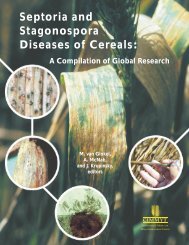Section 3 (Crop Management)
Section 3 (Crop Management)
Section 3 (Crop Management)
You also want an ePaper? Increase the reach of your titles
YUMPU automatically turns print PDFs into web optimized ePapers that Google loves.
Proceedings of the 8 th Asian Regional Maize Workshop, Bangkok, Thailand: August 5-8, 2002<br />
Synchronization of Nitrogen Requirements in Maize/Millet Relay<br />
<strong>Crop</strong>ping System in Mid-Hill Condition of Nepal<br />
P. R. Shakya, B.N. Adhikari, R. P. Upreti and S. Thapa<br />
Hill <strong>Crop</strong> Research Programme (HCRP) Kabre, Dolakha, Nepal<br />
Abstract<br />
An experiment on synchronizing of nitrogen requirement in maize (Zea mays) /millet (Eleusine<br />
coracana Geartn) relay-cropping system was carried out in the Hill <strong>Crop</strong> Research Program (HCRP),<br />
Kabre, (1740 masl), Dolakha during the summer season of 2000 and 2001 to identify the optimum time of<br />
nitrogen application for higher yield of both crops in mid hill condition of Nepal. In addition to 10 ton<br />
compost, chemical fertilizer was applied @60:30:30 NPK kg/ha in all treatments. Compost was<br />
incorporated in the soil at the time of land preparation and all phosphorus and potash was applied at the<br />
time of maize planting. Splitting of nitrogen and time of its application was done to make eight different<br />
treatments and nitrogen was applied accordingly. The experiment was conducted in a RCB design with<br />
four replications in 6.0 m2 plots. The highest maize grain yield (5951 kg/ha) was produced by the<br />
treatment T2 followed by (5680 kg/ha) with the treatment T8. The lowest maize grain yield (4327 kg/ha)<br />
was obtained by T1. Likewise, the highest finger millet grain yield (977 kg/ha) was produced by T6<br />
followed by (906 kg/ha) with the treatment T2. The lowest millet grain yield (715 kg/ha) was obtained in<br />
the treatment T1.<br />
Introduction<br />
Maize (Zea mays) and finger millet (Eleusine coracana Geartn) are the first and third important staple<br />
food crops grown under diverse cropping pattern and environments in the mid hills (1000-2000 masl) of<br />
Nepal. Maize /finger millet relay cropping system is predominant in the upland (bari land) of the mid<br />
hills. The area under maize and millet are 824525 ha and 2,59888 ha respectively. About 28% of the total<br />
maize area in Nepal is relayed/inter cropped with finger millet (Palikhe, 2000). The productivity of maize<br />
and millet are 1.79 t/ha and 1.08 t/ha respectively (2000/2001 CBS). The yield of maize is quite low as<br />
compared to other Asian countries, due to lack of high yielding varieties, unavailability of improved seed<br />
and inadequate supply of plant nutrients. There are other biotic and abiotic factors as well affecting the<br />
crop yield in the hills (Priyadarsi et al., 2000).<br />
Compost and farmyard manure (FYM) are the major sources of plant nutrient in the hills. However,<br />
the consumption of chemical fertilizers is also increasing steadily. The application of FYM is in declining<br />
trend due to decreasing forest resources and increasing labor cost. Nevertheless, farmers are developing<br />
habit of applying urea in the form of top dressing on maize at the time of earthing up maize plant. Now<br />
the main concern from farmers point of view is how much nitrogenous (urea) fertilizer should apply and<br />
what is the right time to apply so that a maximum yield can be obtained. Since the cost of chemical<br />
fertilizers is increasing and at the same time it is very important to improve the efficiency of applied<br />
nitrogenous fertilizers. Since nitrogenous fertilizers are subjected to loss through leaching, volatilization<br />
and de-nitrification. A large number of farmers will be benefited if we could provide information on right<br />
time and amount of urea fertilizer application. This will also save the expensive fertilizers and reduce the<br />
detrimental effect on soil environment. The objective of the study was to find out the right time and<br />
splitting of nitrogen dose in maize on maize/millet cropping system.<br />
- 273 -









